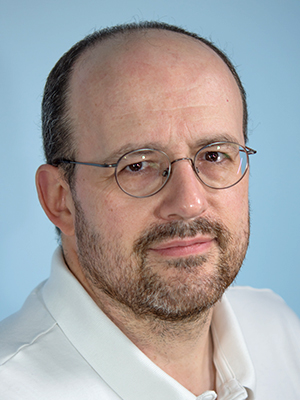The Microscopy and Imaging Core Facility

- Vincent Schram, PhD, Staff Scientist
- Louis (Chip) Dye, BS, Staff Scientist
- Lynne A. Holtzclaw, BS, Senior Research Assistant (Biologist)
The mission of the NICHD Microscopy and Imaging Core (MIC) is to provide service in three different areas: (1) wide-field and confocal light microscopy, (2) transmission electron microscopy (EM), and (3) sample preparation for light and electron microscopy studies.
Vincent Schram is the point person for light microscopy and image analysis and is working in close collaboration with his NINDS counterpart, Carolyn Smith, the director of the Light Imaging Facility, NINDS, also in the Porter Neuroscience building. This mode of operation is beneficial to the community as it provides extended support hours, wider expertise, and access to more equipment than each Institute can afford on its own. The EM branch of the facility is staffed by Chip Dye. Lynne Holtzclaw is in charge of sample preparation. Both report directly to Vincent Schram, who serves as executive director under the management of Chris McBain. Tamás Balla acts as scientific advisor for the facility.
Mode of operation
Located on the ground floor of building 35A, the facility is accessible 24/7, and users can reserve time on each microscope by using an online calendar (https://next.cirklo.org/nichd/). The MIC is available free of charge to all NICHD investigators and, resources allowing, to anyone within the Porter building.
For light microscopy, sample preparation and image acquisition are typically handled by end users, with support and training provided by Lynne Holtzclaw (specimen preparation) and Vincent Schram (imaging acquisition and data analysis). For electron microscopy (EM), most of the sample processing and imaging is done in-house by Chip Dye to ensure consistent and reproducible conditions.
Light microscopy
The facility operates four modern confocal microscopes, each optimized for specific applications: (1) a Zeiss LSM 710 inverted for high-resolution confocal imaging of fixed specimen and live cells; (2) a Zeiss LSM 780 for challenging specimens that require both high resolution and high sensitivity; (3) a Nikon Spinning Disk/Total Internal Reflection Fluorescence (TIRF) hybrid microscope for high-speed confocal imaging or selective recording of membrane-bound events in live cells; (4) a Zeiss LSM 880 2-photon confocal for thick specimen and live animal microscopy, which the facility recently aquired. Several conventional (wide-field) light microscopes provide imaging modalities such as transmission (visible stains), large-scale tiling of tissue slices, high-speed phase contrast, and differential interference contrast (DIC). High-end computer workstations with imaging software (Zeiss Zen, Nikon Element, Bitplane Imaris, SVI Hyugens, Metamorph, and ImageJ) are also available.
After an initial orientation during which the project is discussed and the best approach is decided upon, users receive hands-on training on the equipment and/or software best suited to their goals, followed by continuous support when required. Additional training and support is offered to the community in different ways: (1) on-site assistance and training on equipment owned by individual investigators; (2) a yearly workshop on microscopy covering light and electron microscopy, image analysis, and sample processing, organized by the MIC; (3) FAES courses on microscopy, which MIC staff volunteer to teach; (4) frequent campus-wide demonstrations of new instruments and software by vendors in the field, which the MIC organizes.
The MIC has a total of 210 registered users in 65 laboratories. At 7,582 instrument hours, overall usage has grown slightly since last fiscal year, although this figure includes wide-field microscopes, which are now seeing significant usage. Half of the total usage is by NICHD investigators, most of them within the Porter building. The MIC used an additional 21% of resources for training and pilot projects, and other Institutes, predominantly NINDS, used the remaining 28%. All three confocal microscopes were used equally at an average of 43 hours per week. To alleviate this high usage, the facility is acquiring two additional point scanning instruments.
Electron microscopy
The electron microscopy branch of the facility processes specimens from start to finish: fixation, embedding, cutting, ultra-fine sectioning, staining, and imaging on the JEOL 1400 transmission electron microscope. Because of the labor involved, the volume is necessarily smaller than the light microscopy branch, where end users do their own processing. In the past 12 months, Chip Dye processed a total of 85 samples: 70 from NICHD investigators, nine from MIC internal test projects, and six from other Institutes.
Thanks to a gift from Joshua Zimmerberg, the facility received an AMT Biosprint 29 camera with a wider field of view, enhanced resolution, and slightly lower pixel size. The JEOL 1400 electron microscope is now on the facility’s calendar, and trained investigators have direct access to the instrument. After the MIC, Joshua Zimmerberg’s (NICHD) and Ling-Gang Wu’s (NINDS) groups are the major users.
Tissue preparation
Lynne Holtzclaw continues to provide sample processing training and services to the facility’s users, both for light and electron microscopy applications. She spends a significant amount of time training users in various techniques such as rodent perfusion, cryopreservation, cryosectioning, immunofluorescence, and tissue clearing. During the past year, she trained staff, processed samples and acquired images for Tamás Balla, Jeffrey Baron, Peter Basser, Sergei Bezrukov, Juan Bonifacino, Robert Crouch, Mary Dasso, Douglas Fields, Dax Hoffman, David Klein, Mary Lilly, Peng Loh, Chris McBain, Anil Mukherjee, Keiko Ozato, Mario Penzo (NIMH), Forbes Porter, Stanko Stojilkovic, Mark Stopfer, and Constantine Stratakis.
At the same time, she is pursuing a collaborative endeavor with David Klein on rat pineal glands to characterize the cell types in which three genes of interest, identified by single-cell RNA sequencing, are located. The project includes perfusion, cryosectioning of pineal glands, immunofluorescence, and imaging.
Collaborators
- Carolyn L. Smith, PhD, Light Imaging Facility, NINDS, Bethesda, MD
- John E. Heuser, PhD, Section on Integrative Biophysics, NICHD, Bethesda, MD
Contact
For more information, email schramv@mail.nih.gov or visit http://mic.nichd.nih.gov.


